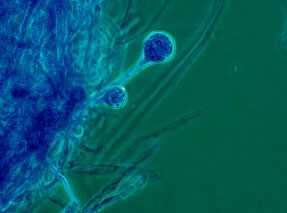Sources of Mucormycosis

Photomicrograph of Apophysomyces trapeziformis
The fungi that cause mucormycosis live in the environment
Mucormycetes, the group of fungi that cause mucormycosis, are present throughout the environment, particularly in soil and in association with decaying organic matter, such as leaves, compost piles, or rotten wood.1 Most people come in contact with microscopic fungal spores every day, so it’s probably impossible to completely avoid coming in contact with mucormycetes. For most people, these fungi aren’t harmful. However, for people who have weakened immune systems, breathing in mucormycete spores can cause an infection in the lungs or sinuses which can spread to other parts of the body.
Types of fungi that cause mucormycosis
Several different types of fungi can cause mucormycosis. These fungi are called mucormycetes and belong to the scientific order Mucorales. The most common types that cause mucormycosis are Rhizopus species and Mucor species.2 Other examples include Cunninghamella bertholletiae, Apophysomyces, Lichtheimia (formerly Absidia), Saksenaea, and Rhizomucor.2
References
- Richardson M. The ecology of the Zygomycetes and its impact on environmental exposure. Clin Microbiol Infect. 2009 Oct;15 Suppl 5:2-9.
- Roden MM, Zaoutis TE, Buchanan WL, Knudsen TA, Sarkisova TA, Schaufele RL, et al. Epidemiology and outcome of zygomycosis: a review of 929 reported cases. Clin Infect Dis. 2005 Sep 1;41(5):634-53.
- Page last reviewed: December 30, 2015
- Page last updated: December 30, 2015
- Content source:


 ShareCompartir
ShareCompartir